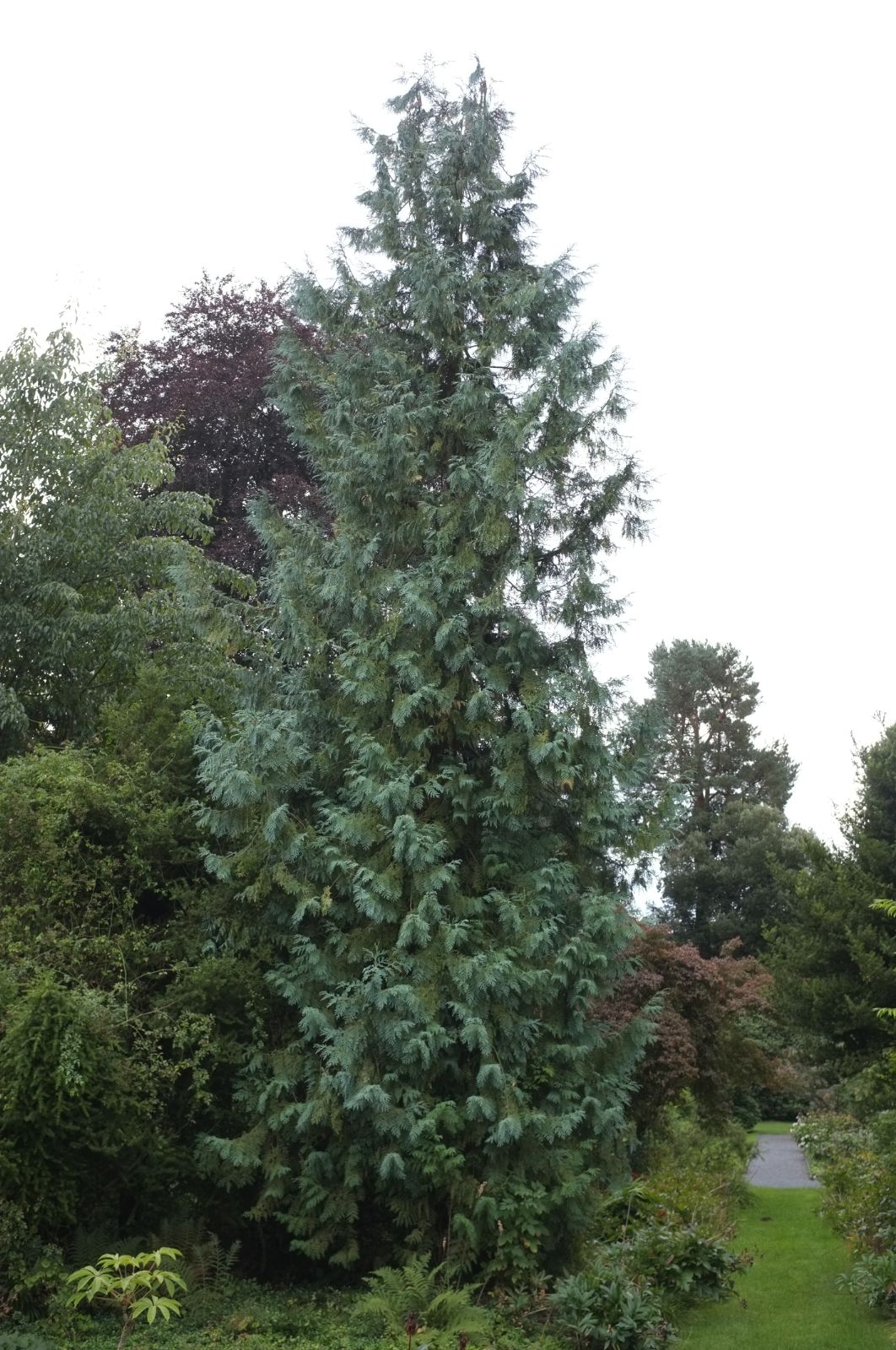Thuja koraiensis
Credits
Article from New Trees by John Grimshaw & Ross Bayton
Recommended citation
'Thuja koraiensis' from the website Trees and Shrubs Online (treesandshrubsonline.
Genus
Common Names
- Korean Arborvitae
Editorial Note
W.J. Bean discussed Thuja koraiensis in a footnote to his article on T. standishii. For ease of reference, we have moved Bean’s account here, below the T. koraiensis account from New Trees, pending a full revision of this genus.
TC, February 2024.
Shrub or small tree to 10 m (or more in cultivation), 0.8 m dbh. Bark smooth, reddish brown, becoming greyish brown, flaky and fissured in older trees. Crown conical or domed, rather open. Branchlets glaucous, then green. Leaves densely crowded, dimorphic; lateral pairs equal to or shorter than the facial pairs, facial pairs 0.2–1.5 cm long, obtuse; lower surface with a conspicuous covering of glaucous stomata bands; leaves releasing a strong smell of almonds when crushed. Male strobili subglobose, 0.2–0.3 cm long, with 6–10 microsporophylls. Seed cones dark brown, globose to ovoid, 0.7–1 × 0.6–0.8 cm. Seed scales in four pairs, valvate, only the middle two pairs fertile, the apical pair narrow and elongated. Seeds ellipsoid, 0.4 × 0.1 cm; wings two, equal, 1–1.5 cm wide, translucent. Fu et al. 1999e, Farjon 2005c. Distribution CHINA: Jilin; NORTH KOREA; SOUTH KOREA. Habitat Valleys and mountain ridges, between 700 and 1800 m asl. USDA Hardiness Zone 5. Conservation status Data Deficient (IUCN). Illustration Fu et al. 1999e; NT246, NT853. Cross-references B586, S512, K295.
Thuja koraiensis was discussed by Bean (1981b), but without provision of a technical description, allowing us to include this sometimes extremely attractive species in our account. The word ‘sometimes’ is used deliberately here, as it can be a rather undistinguished low shrub, in the wild as well as in cultivation, and such plants have little horticultural merit. Examples of recently introduced material with this habit can be seen at the Morris Arboretum, collected (as cuttings) by the 1989 US National Arboretum expedition to Korea (NEKG 117), at 1300 m in the Taebaek Mountains. The field notes relate that it formed an ‘attractive ground cover’ below a mixed canopy. Other specimens make attractive columnar trees, resembling T. plicata but with sparser branching and much less vigour. All show some glaucescence on the undersides of the shoots, but this varies enormously in extent. The most familiar stock in cultivation, derived from Wilson 9244, shows a moderate degree of glaucescence on columnar trees (to c.15 m at Hergest Croft, planted in 1925). At Kew, a young tree planted near the Orangery has minimal glaucescence and is a somewhat dull olive-green. This was grown from seed collected in 1989 at 750 m in the Mount Soraksan Nature Reserve, South Korea by the Kirkham, Flanagan & Boyce Expedition to Korea (KFBX 56). At the other end of the scale are the wonderfully glaucous specimens growing in the Netherlands at the University of Utrecht Botanic Garden and Von Gimborn Arboretum, which deserve a cultivar name as the bluest of all Thuja. Commercially available plants in Europe, while glaucous, do not match the quality of these, but are apparently of tree form. American nurseries sell plants under the (illegitimate) names ‘Glauca’, ‘Glauca Nana’ and ‘Glauca Prostrata’, but it is not clear if these are different or merely nomenclatural variants for the same bushy clone. Thuja koraiensis seems to be amenable to a diversity of sites and conditions, but even the true tree-forming specimens are slow-growing compared with T. plicata. The foliage has a particularly pleasant aroma – ‘rich fruit cake with plenty of almonds’, according to Mitchell (1972).
From Bean’s Trees and Shrubs:
According to Wilson, this species, as he saw it in Korea, is ‘remarkable in its variations of habit from a sprawling shrub of nondescript shape to a slender, graceful, narrowly pyramidal tree.’ (Journ. Am. Arb., Vol. 1 (1919), p. 186). He gives its maximum height as 25 to 30 ft, but this it rarely attains and usually it forms an impenetrable tangle 1 to 2 yards high.T. koraiensis is closely allied to T. standishii, but the leaf sprays are flatter and the undersides of the leaves are unusually glaucous for this genus, almost silvery. The aroma of the crushed leaves has been likened by Alan Mitchell to that of rich fruit-cake ‘with plenty of almonds’, against that of oil of citronella or lemon-scented verbena in T. standishii. Wilson introduced this species in 1917 from the Diamond Mountains of northern Korea, and probably all the largest plants in collections are from his seeds (W. 9244); these, or plants raised from them, were distributed by F. R. S. Balfour of Dawyck, who organised the British share of the financing of Wilson’s expedition. These plants are mostly 20 to 33 ft high and 1 to 2 ft in girth.




